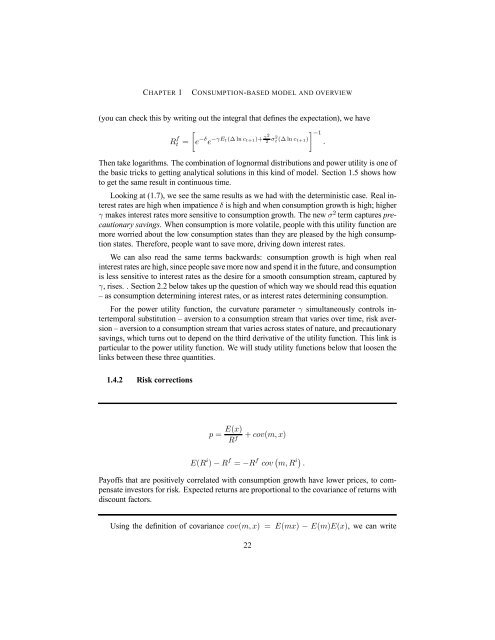Asset Pricing John H. Cochrane June 12, 2000
Asset Pricing John H. Cochrane June 12, 2000
Asset Pricing John H. Cochrane June 12, 2000
You also want an ePaper? Increase the reach of your titles
YUMPU automatically turns print PDFs into web optimized ePapers that Google loves.
CHAPTER 1 CONSUMPTION-BASED MODEL AND OVERVIEW<br />
(you can check this by writing out the integral that defines the expectation), we have<br />
R f<br />
·<br />
t = e −δ e −γEt(∆ ln ct+1)+ γ2<br />
2 σ2 ¸−1 t (∆ ln ct+1)<br />
.<br />
Then take logarithms. The combination of lognormal distributions and power utility is one of<br />
the basic tricks to getting analytical solutions in this kind of model. Section 1.5 shows how<br />
to get the same result in continuous time.<br />
Looking at (1.7), we see the same results as we had with the deterministic case. Real interest<br />
rates are high when impatience δ is high and when consumption growth is high; higher<br />
γ makes interest rates more sensitive to consumption growth. The new σ2 term captures precautionary<br />
savings. When consumption is more volatile, people with this utility function are<br />
more worried about the low consumption states than they are pleased by the high consumption<br />
states. Therefore, people want to save more, driving down interest rates.<br />
We can also read the same terms backwards: consumption growth is high when real<br />
interest rates are high, since people save more now and spend it in the future, and consumption<br />
is less sensitive to interest rates as the desire for a smooth consumption stream, captured by<br />
γ, rises. . Section 2.2 below takes up the question of which way we should read this equation<br />
– as consumption determining interest rates, or as interest rates determining consumption.<br />
For the power utility function, the curvature parameter γ simultaneously controls intertemporal<br />
substitution – aversion to a consumption stream that varies over time, risk aversion<br />
– aversion to a consumption stream that varies across states of nature, and precautionary<br />
savings, which turns out to depend on the third derivative of the utility function. This link is<br />
particular to the power utility function. We will study utility functions below that loosen the<br />
links between these three quantities.<br />
1.4.2 Risk corrections<br />
p = E(x)<br />
+ cov(m, x)<br />
Rf E(R i ) − R f = −R f cov ¡ m, R i¢ .<br />
Payoffs that are positively correlated with consumption growth have lower prices, to compensate<br />
investors for risk. Expected returns are proportional to the covariance of returns with<br />
discount factors.<br />
Using the definition of covariance cov(m, x) = E(mx) − E(m)E(x), we can write<br />
22
















